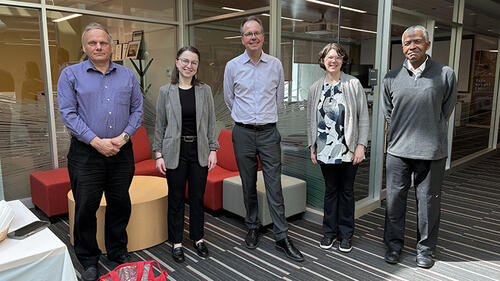
On Thursday, April 10, Arina Telles successfully defended the thesis “Microwave Techniques for Neutrino Mass Measurement” (advisor: Karsten Heeger).
Telles explained, “Neutrino mass remains one of the unsolved mysteries in particle and nuclear physics today. Project 8 is a collaboration that is developing a next-generation experiment to measure the neutrino mass using a radio frequency-based technique called Cyclotron Emission Radiation Spectroscopy. Over the course of my PhD, I worked on antenna arrays, meta-materials, and resonant cavities as various approaches to this puzzle. My thesis presents these microwave techniques uniquely applied to neutrino mass experiments, and advances Project 8 R&D efforts as a whole.”
Telles’ next position is as an Electromagnetics Researcher at Raytheon Technologies Research Center, where she will be conducting research in antennas and meta-materials for aerospace and defense applications.
Thesis Abstract: Direct neutrino mass measurement is one of the frontiers of particle and nuclear physics, with the most recent measurements setting an upper bound of mβ < 0.45 eV c−2 and cosmological models and observations predicting a value of Σ mi < 0.12 eV c−2. The next generation of neutrino mass experiments require new technology to push beyond the statistical and systematic limits of current measuring capabilities. Project 8 is a collaboration seeking to make this possible by combining the well-established tritium endpoint method with a relatively new technique called Cyclotron Radiation Emission Spectroscopy (CRES). CRES uses the radio-frequency (RF) emission of electrons undergoing cyclotron motion to precisely measure the tritium beta spectrum. RF detectors and detection techniques tailored for CRES are the subject of this thesis, with three areas of focus: antenna arrays, meta-material insulation, and resonant cavities. A comprehensive investigation of antenna arrays is presented with an idealized case study reaching the Project 8 goal of 40 meV c−2. Design, simulation, and measurement of an infrared (IR)-reflecting, RF-transparent meta-material is shown for potential application with antenna arrays. A conceptual design study of resonant cavity-based CRES is also described for the purpose of future Project 8 demonstrator experiments. These developments contribute new microwave techniques to the large-scale R&D effort for constraining the neutrino mass.
Thesis Committee: Karsten Heeger (advisor), Witold Skiba, Laura Newburgh, Keith Baker, and Pranava Teja Surukuchi